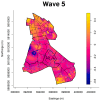Exploring the Spatial Relative Risk of COVID-19 in Berlin-Neukölln
- PMID: 37239558
- PMCID: PMC10218333
- DOI: 10.3390/ijerph20105830
Exploring the Spatial Relative Risk of COVID-19 in Berlin-Neukölln
Abstract
Identifying areas with high and low infection rates can provide important etiological clues. Usually, areas with high and low infection rates are identified by aggregating epidemiological data into geographical units, such as administrative areas. This assumes that the distribution of population numbers, infection rates, and resulting risks is constant across space. This assumption is, however, often false and is commonly known as the modifiable area unit problem. This article develops a spatial relative risk surface by using kernel density estimation to identify statistically significant areas of high risk by comparing the spatial distribution of address-level COVID-19 cases and the underlying population at risk in Berlin-Neukölln. Our findings show that there are varying areas of statistically significant high and low risk that straddle administrative boundaries. The findings of this exploratory analysis further highlight topics such as, e.g., Why were mostly affluent areas affected during the first wave? What lessons can be learned from areas with low infection rates? How important are built structures as drivers of COVID-19? How large is the effect of the socio-economic situation on COVID-19 infections? We conclude that it is of great importance to provide access to and analyse fine-resolution data to be able to understand the spread of the disease and address tailored health measures in urban settings.
Keywords: COVID-19; infectious disease; kernel density; modifiable areal unit problem; point data; spatial relative risk.
Conflict of interest statement
The authors declare no conflict of interest.
Figures








Similar articles
-
The spatio-temporal distribution of COVID-19 infection in England between January and June 2020.Epidemiol Infect. 2021 Mar 8;149:e73. doi: 10.1017/S0950268821000534. Epidemiol Infect. 2021. PMID: 33678199 Free PMC article.
-
Infection rates from Covid-19 in Great Britain by geographical units: A model-based estimation from mortality data.Health Place. 2021 Jan;67:102460. doi: 10.1016/j.healthplace.2020.102460. Epub 2020 Oct 19. Health Place. 2021. PMID: 33418438 Free PMC article.
-
Exploration of the COVID-19 pandemic at the neighborhood level in an intra-urban setting.Front Public Health. 2023 Apr 13;11:1128452. doi: 10.3389/fpubh.2023.1128452. eCollection 2023. Front Public Health. 2023. PMID: 37124802 Free PMC article.
-
[Spatial analysis for detecting clusters of cases during the COVID-19 emergency in Rome and in the Lazio Region (Central Italy)].Epidemiol Prev. 2020 Sep-Dec;44(5-6 Suppl 2):144-151. doi: 10.19191/EP20.5-6.S2.113. Epidemiol Prev. 2020. PMID: 33412805 Italian.
-
Evaluating the impact of the Modifiable Areal Unit Problem on ecological model inference: A case study of COVID-19 data in Queensland, Australia.Infect Dis Model. 2025 May 10;10(3):1002-1019. doi: 10.1016/j.idm.2025.05.003. eCollection 2025 Sep. Infect Dis Model. 2025. PMID: 40495898 Free PMC article.
Cited by
-
Effect of urban structure, population density and proximity to contagion on COVID-19 infections during the SARS-CoV-2 Alpha and Omicron waves in Málaga, Spain, March 2020 to December 2021.Euro Surveill. 2025 Jan;30(3):2400174. doi: 10.2807/1560-7917.ES.2025.30.3.2400174. Euro Surveill. 2025. PMID: 39850003 Free PMC article.
-
Pathogenic built environment? Reflections on modeling spatial determinants of health in urban settings considering the example of COVID-19 studies.Front Public Health. 2025 Mar 17;13:1502897. doi: 10.3389/fpubh.2025.1502897. eCollection 2025. Front Public Health. 2025. PMID: 40165988 Free PMC article.
References
-
- WHO WHO Director-General’s Opening Remarks at the Media Briefing on COVID-19. 2020. [(accessed on 11 March 2020)]. Available online: https://www.who.int/director-general/speeches/detail/who-director-genera....
-
- RKI Epidemiologisches 2022 Bulletin—Aktualisierte Phaseneinteilung der COVID-19-Pandemie (10/2022) 2022. [(accessed on 21 March 2022)]. Available online: https://www.rki.de/DE/Content/Infekt/EpidBull/Archiv/2022/Ausgaben/10_22....
-
- Rossman H., Keshet A., Shilo S., Gavrieli A., Bauman T., Cohen O., Shelly E., Balicer R., Geiger B., Dor Y., et al. A framework for identifying regional outbreak and spread of COVID-19 from one-minute population-wide surveys. Nat. Med. 2020;26:634–638. doi: 10.1038/s41591-020-0857-9. - DOI - PMC - PubMed
Publication types
MeSH terms
LinkOut - more resources
Full Text Sources
Medical

